T.D. Wilson's Blog, page 25
October 10, 2013
Science Fiction Trivia TimeEvery week I plan to post a ne...
Science Fiction Trivia Time
Every week I plan to post a new science fiction or fantasy trivia question. If you don't see one from me, please just poke me because I may have gotten distracted.
Anyway, this week's question is:
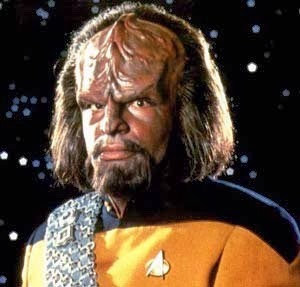
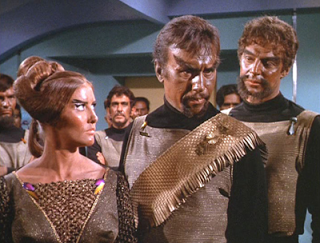
The Klingon language, since its inception, has spawned its own dictionary, has been used widely in Star Trek movies and TV, and is now actively spoken at Star Trek (and even Klingon conventions or gatherings). Who came up with the Klingon language concept and when?
Every week I plan to post a new science fiction or fantasy trivia question. If you don't see one from me, please just poke me because I may have gotten distracted.
Anyway, this week's question is:


The Klingon language, since its inception, has spawned its own dictionary, has been used widely in Star Trek movies and TV, and is now actively spoken at Star Trek (and even Klingon conventions or gatherings). Who came up with the Klingon language concept and when?
Published on October 10, 2013 16:26
October 4, 2013
RAILGUNS "The Series" Part 3Use in Science FictionIn my t...
RAILGUNS "The Series" Part 3
Use in Science Fiction
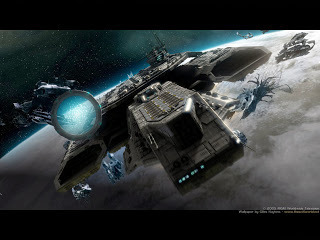
In my two previous posts on this topic, we looked at the concept and then the history of the railgun. As you might have guessed, if these weapons were to fully fielded, their firepower could have a dramatic effect on the battlefields we know today. However, we still struggle to overcome many of the limitations for power, physics, materials, and feasibility. Given time, I believe we can find a way to bring these weapons out of concept phases and make them truly combat ready.
In this segment, I wanted to focus on where railguns have been used or discussed in science fiction books, TV, movies, and especially in role-playing and video games. Now before I begin, I do want to note that not all the references listed here are true railgun implementations. Many are based on the coilgun. I plan to talk more about the coilgun features in another post, but for brevity, the coilgun uses magnetic fields from electrical wire coils to accelerate a projectile. A projectile would be accelerated by the magnetic fields in the center of the coils. An example of the coilgun would be a Gauss Rifle or a mass driver.
Now, where have we seen references to railguns or electric guns in literature? One of the prominent novel series to showcase railguns was old favorite of mine, Buck Rogers. Another example hails from 1955, when Arthur C. Clark used a weapon in his novel Earthlight that propelled a piece of molten metal for projectile. In a railgun, this implementation wouldn't work, but it was one of the earliest references. Perhaps the earliest example was in 1897, but it was for a coilgun. John Munro's A Trip to Venus used a large electric gun to launch vehicles into space and later could be modified to send reinforced projectiles as a weapon.
I have found several references to mass drivers and Gauss Rifles in different books. The Mechwarrior and Battletech books had Gauss Rifles on mechs, tanks, and spaceships (lots of these books were really good, but the ones written by Michael A. Stackpole were superb). Henry Harrison's book The Stainless Steel Rat's Revenge was another that used Gauss Rifles. For true railguns, Redemption Ark, by Alastair Reynolds and Old Man's War by John Scalzi were good examples of railguns deployed on spaceships. There are several others, some of which had hand-held versions of railguns, but these are the ones I am most familiar.
So, what about TV series? Well, the first one that came to mind for me was Stargate: Atlantis. The use of the railguns was an excellent ideas and they could easily be powered by Asgardian power cores, but the implementation here to me was not realistic. The rate of fire was way to high. The show seemed to treat the railgun more as point defense weapons and had no real damaging effect against other large ships, even those that didn't have shields.
In Babylon 5 (one of my all time favorite sci-fi series), the Centauri used mass drivers to pummel the Narn homeworld. I tried to dig up some more Earth based uses for railguns or mass drivers for the show or the role-playing game, but I haven't found any.
Space Above and Beyond had mention that cannons were railguns, but the design use doesn't fit either. There were some big cannons on the carriers, but we never got to see if these were railguns or some sort of particle weapon.
There is still some debate about the type of weapons used by the Battlestars in the latest rendition of Battlestar Galactica. Some believe the main weapons, particularly on the newer Pegasus were railguns. The design of the weapons for the Galactica still look to be a conventional weapon design. They could work in space, but the round or firing chamber would have to have some oxygen available.
Now there are some really cool anime series that used railguns; specifically, Macross (Robotech). The SDF-1 was equipped with four huge railguns, as were the Mach II Destroids (my friend Jeff is a huge fan of those). The Justice League cartoon series had a reference to mass drivers via the perennial villain Vandal Savage.
There may be some more TV references that I am not aware, so please post comments for those you know.
Now on to the big screen. There are a few big films that showcased some type of electromagnetic projectile weapon. The Last Starfighter (a movie that I really wanted a sequel made) contained the meteor gun, which was a large mass driver used by the Kodan to attack the Starfighter base. The movie, Eraser, which starred Arnold Schwarzenegger, used a hand-held railgun weapon that was complete with x-ray optics. Demolition Man was another to depict the railgun as a hand-held weapon.
In Aliens, the Marine warship, Sulaco, had several large gun emplacements. In many discussions and data provided about the ship, it was stated that some of the guns were railguns, but we never got to see them in action. Hmm, nuke it from orbit or lob a few sorties down to the planet and let the aliens suck on those. Tough call.
More recently, Transformers: Revenge of the Fallen used a navy ship based railgun to destroy Devastator when he was tearing apart a pyramid. This was probably the most realistic example of a railgun in the field of any of the movies or TV shows I have seen, but it was only used once. In this case, once was enough and you could see the amount of damage it inflicted even at long range.
The Zeus System in G.I. Joe: Retaliation was an example of a mass driver. However, the system relied more on gravity to accelerate its projectiles. Speed kills and this implementation used it to devastating effect.
I believe the newest railgun implementation in a movie was in Elysium with its ChemRail gun.
Finally, lets look at games. Remarkably, I have found the most references to the use of railguns and coilguns in different fashions in role-playing or video games. Lets start with role-playing/table-top games. I was always a big BattleTech fan and Gauss Rifles were a great weapon for damage and range. I played Traveler a few times, but I never realized there were Gauss style weapons. Another iconic game, WarHammer 40000 has its Tau railguns. The game used railguns for tanks, aircraft and powered armor. Another game I loved playing was Palladium's Rifts. There was so much source material to use. Lots of powered armor and big weapons, especially the GlitterBoy armor. The armor had good protection and one big railgun.
As you can imagine, video games have so many implementations for railguns. Command and Conquer, Armored Core, Metal Gear solid, some of the Ace Combat series games, Descent 3, Total Annihilation (I loved that game), Star Craft, Tachyon: The Fringe (ok game, but it had Bruce Campbell in it so it had to be good, right?), several Quake games, and the Master of Orion game series. You can find them all over the Halo game universe, they are in Half-life, and most importantly, they were used in the Mass Effect games. Commander John Shepard for the win! Who's with me?
This list is only a fraction of the games I found references for railguns, but these are the ones I have played. Kinda wonder how much free time I really had over the years, huh? I must say that I budgeted it well.
That's it for this installment. In my next post, I will explain my vision for the use of railguns in the future and how I have employed them in my sci-fi book series, The Epherium Chronicles. As always, if you have more information on railguns and their use in sci-fi for books, TV, movies, or games, please post it and share.
Use in Science Fiction

In my two previous posts on this topic, we looked at the concept and then the history of the railgun. As you might have guessed, if these weapons were to fully fielded, their firepower could have a dramatic effect on the battlefields we know today. However, we still struggle to overcome many of the limitations for power, physics, materials, and feasibility. Given time, I believe we can find a way to bring these weapons out of concept phases and make them truly combat ready.
In this segment, I wanted to focus on where railguns have been used or discussed in science fiction books, TV, movies, and especially in role-playing and video games. Now before I begin, I do want to note that not all the references listed here are true railgun implementations. Many are based on the coilgun. I plan to talk more about the coilgun features in another post, but for brevity, the coilgun uses magnetic fields from electrical wire coils to accelerate a projectile. A projectile would be accelerated by the magnetic fields in the center of the coils. An example of the coilgun would be a Gauss Rifle or a mass driver.
Now, where have we seen references to railguns or electric guns in literature? One of the prominent novel series to showcase railguns was old favorite of mine, Buck Rogers. Another example hails from 1955, when Arthur C. Clark used a weapon in his novel Earthlight that propelled a piece of molten metal for projectile. In a railgun, this implementation wouldn't work, but it was one of the earliest references. Perhaps the earliest example was in 1897, but it was for a coilgun. John Munro's A Trip to Venus used a large electric gun to launch vehicles into space and later could be modified to send reinforced projectiles as a weapon.
I have found several references to mass drivers and Gauss Rifles in different books. The Mechwarrior and Battletech books had Gauss Rifles on mechs, tanks, and spaceships (lots of these books were really good, but the ones written by Michael A. Stackpole were superb). Henry Harrison's book The Stainless Steel Rat's Revenge was another that used Gauss Rifles. For true railguns, Redemption Ark, by Alastair Reynolds and Old Man's War by John Scalzi were good examples of railguns deployed on spaceships. There are several others, some of which had hand-held versions of railguns, but these are the ones I am most familiar.
So, what about TV series? Well, the first one that came to mind for me was Stargate: Atlantis. The use of the railguns was an excellent ideas and they could easily be powered by Asgardian power cores, but the implementation here to me was not realistic. The rate of fire was way to high. The show seemed to treat the railgun more as point defense weapons and had no real damaging effect against other large ships, even those that didn't have shields.
In Babylon 5 (one of my all time favorite sci-fi series), the Centauri used mass drivers to pummel the Narn homeworld. I tried to dig up some more Earth based uses for railguns or mass drivers for the show or the role-playing game, but I haven't found any.
Space Above and Beyond had mention that cannons were railguns, but the design use doesn't fit either. There were some big cannons on the carriers, but we never got to see if these were railguns or some sort of particle weapon.
There is still some debate about the type of weapons used by the Battlestars in the latest rendition of Battlestar Galactica. Some believe the main weapons, particularly on the newer Pegasus were railguns. The design of the weapons for the Galactica still look to be a conventional weapon design. They could work in space, but the round or firing chamber would have to have some oxygen available.
Now there are some really cool anime series that used railguns; specifically, Macross (Robotech). The SDF-1 was equipped with four huge railguns, as were the Mach II Destroids (my friend Jeff is a huge fan of those). The Justice League cartoon series had a reference to mass drivers via the perennial villain Vandal Savage.
There may be some more TV references that I am not aware, so please post comments for those you know.
Now on to the big screen. There are a few big films that showcased some type of electromagnetic projectile weapon. The Last Starfighter (a movie that I really wanted a sequel made) contained the meteor gun, which was a large mass driver used by the Kodan to attack the Starfighter base. The movie, Eraser, which starred Arnold Schwarzenegger, used a hand-held railgun weapon that was complete with x-ray optics. Demolition Man was another to depict the railgun as a hand-held weapon.
In Aliens, the Marine warship, Sulaco, had several large gun emplacements. In many discussions and data provided about the ship, it was stated that some of the guns were railguns, but we never got to see them in action. Hmm, nuke it from orbit or lob a few sorties down to the planet and let the aliens suck on those. Tough call.
More recently, Transformers: Revenge of the Fallen used a navy ship based railgun to destroy Devastator when he was tearing apart a pyramid. This was probably the most realistic example of a railgun in the field of any of the movies or TV shows I have seen, but it was only used once. In this case, once was enough and you could see the amount of damage it inflicted even at long range.
The Zeus System in G.I. Joe: Retaliation was an example of a mass driver. However, the system relied more on gravity to accelerate its projectiles. Speed kills and this implementation used it to devastating effect.
I believe the newest railgun implementation in a movie was in Elysium with its ChemRail gun.
Finally, lets look at games. Remarkably, I have found the most references to the use of railguns and coilguns in different fashions in role-playing or video games. Lets start with role-playing/table-top games. I was always a big BattleTech fan and Gauss Rifles were a great weapon for damage and range. I played Traveler a few times, but I never realized there were Gauss style weapons. Another iconic game, WarHammer 40000 has its Tau railguns. The game used railguns for tanks, aircraft and powered armor. Another game I loved playing was Palladium's Rifts. There was so much source material to use. Lots of powered armor and big weapons, especially the GlitterBoy armor. The armor had good protection and one big railgun.
As you can imagine, video games have so many implementations for railguns. Command and Conquer, Armored Core, Metal Gear solid, some of the Ace Combat series games, Descent 3, Total Annihilation (I loved that game), Star Craft, Tachyon: The Fringe (ok game, but it had Bruce Campbell in it so it had to be good, right?), several Quake games, and the Master of Orion game series. You can find them all over the Halo game universe, they are in Half-life, and most importantly, they were used in the Mass Effect games. Commander John Shepard for the win! Who's with me?
This list is only a fraction of the games I found references for railguns, but these are the ones I have played. Kinda wonder how much free time I really had over the years, huh? I must say that I budgeted it well.
That's it for this installment. In my next post, I will explain my vision for the use of railguns in the future and how I have employed them in my sci-fi book series, The Epherium Chronicles. As always, if you have more information on railguns and their use in sci-fi for books, TV, movies, or games, please post it and share.
Published on October 04, 2013 13:50
September 23, 2013
What was the Best Sci-fi/Fantasy Movie of the Summer?Now ...
What was the Best Sci-fi/Fantasy Movie of the Summer?
Now that the summer of 2013 is officially over, what was the best sci-fi/fantasy movie? I put together a quick poll, but I want everyone to not only vote. I want them to post comments on why they think their choice was the best. If you think one was second best, please post it. I am sure many readers would want to know which movie you thought was the worst as well. If I don't have your choice listed, please comment and let me know. I will update the poll until Oct 5. What was the best Sci-fi/Fantasy Movie of the Summer?
Now that the summer of 2013 is officially over, what was the best sci-fi/fantasy movie? I put together a quick poll, but I want everyone to not only vote. I want them to post comments on why they think their choice was the best. If you think one was second best, please post it. I am sure many readers would want to know which movie you thought was the worst as well. If I don't have your choice listed, please comment and let me know. I will update the poll until Oct 5. What was the best Sci-fi/Fantasy Movie of the Summer?
Published on September 23, 2013 12:03
September 20, 2013
A Quick Word About Publishing and RejectionI came across ...
A Quick Word About Publishing and Rejection
I came across this article and I thought it was really inspiring for those of us who have tried to publish something and been rejected. It takes patience; it takes perseverance; it takes hope; it takes faith. There are at least a dozen other qualities, but each person has to find their way. The list doesn't include C.S. Lewis who was rejected over 800 times or Louis L'Amour was rejected 200 times. Dr. Seuss was rejected repeatedly and F. Scott Fitzgerald was even told by an editor that he would have a great book, if only he would get rid of that Gatzby character.
Anyway, its a good list and many will find inspiration.
Twenty brilliant authors whose work was initially rejected
If any one else out there has a story to tell regarding their struggles with becoming published or their current journey, please share.
I came across this article and I thought it was really inspiring for those of us who have tried to publish something and been rejected. It takes patience; it takes perseverance; it takes hope; it takes faith. There are at least a dozen other qualities, but each person has to find their way. The list doesn't include C.S. Lewis who was rejected over 800 times or Louis L'Amour was rejected 200 times. Dr. Seuss was rejected repeatedly and F. Scott Fitzgerald was even told by an editor that he would have a great book, if only he would get rid of that Gatzby character.
Anyway, its a good list and many will find inspiration.
Twenty brilliant authors whose work was initially rejected
If any one else out there has a story to tell regarding their struggles with becoming published or their current journey, please share.
Published on September 20, 2013 14:12
September 17, 2013
RAILGUNS "The Series"Part 2 - HistoryIn my last installme...
RAILGUNS "The Series"Part 2 - History
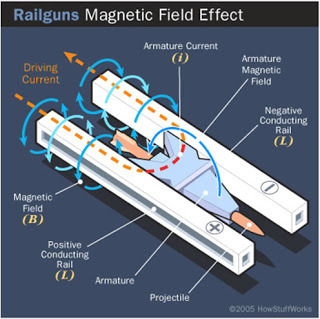
In my last installment of Railguns "The Series", I started off by describing what is a railgun and how it compares to the function of an electric motor. This time, let's take a look at the history of the railgun and a little bit of why the railgun is considered to be a potential weapon for ships, portable field artillery, and even small arms.
Most historians view the first railgun design as the developed by French Inventor Louis Octave Fauchon-Villeplee. It was an electric cannon, He applied for a US Patent and it was issued in 1922. The first working railgun was fielded by Joachim Hansler of Germany during World War II. The design, while feasible, only accelerated projectiles to about 1 km/sec. The velocity was slightly slower than conventional rounds, but the design was a fantastic achievement. He planned to take the design to make a new anti-aircraft cannon. That version of the cannon was never built, but plans that were later discovered showed the design to be technically feasible. Although, the power required to achieve the muzzle velocity for the explosive laden projectile and the rate of fire would have required a small nuclear reactor.
Later in the 1960s, Australian physicists created a larger version of the railgun, but struggled with solid armature projectiles achieving greater than 3 km/sec velocities. They added a new wrinkle to the design; plasma. A small fuse was inserted behind a non-conductive projectile (usually a nylon cube). The concept of the fuse is to become the initial circuit between the rails. As the fuse is consumed by the current, it becomes super-heated plasma. During the process, the electromotive force generated by the magnetic fields thrusts the projectile forward.
Over the past few decades, we have seen more advancements in railgun design. In 2003, the British Ministry of Defense tested a 1/8 scale railgun design. The muzzle velocity for that test reached Mach 6. An impressive step for a the next larger scale weapon, primary for ships or large platforms.
In 2012, BAE delivered and tested a railgun for the US Navy. The picture of the gun is below:
[image error]
The tests for this gun provided speeds roughly at 4500 to 5600 mph and were set for ranges of 50 to 100 nautical miles. Not bad at all. Average effective range for most naval gun ordinance is about 12 miles, except the larger 16 in guns of the Iowa Class battleships that ranged about 18.
General Atomics has also developed a new railgun. Here is a video of their offering called the Blitzer System whick was designed for the Navy.
Now there are still some issues that we continue to face. Power is one of the most prevalent, but with a nuclear powered vessel, those can be minimized. Rail wear and malformation are still an issue. The friction and effect of the high current passing through the rails is significant and has been a issue from the earliest of designs. Rate of fire will not be high due to the power required and wear on the rails. Repulsion is a another issue to consider. Whether the projectile is a solid armature or a plasma "hybrid", there is significant force pressing outward on the rails that can cause stress and warping. In space, reaction force to the liner electromagnetic force must be dealt with. Having a ship in the water or a platform on the ground makes is a lot easier.
Next time we will talk about the use of railguns in our favorite sci-fi books, tv shows, and movies. Don't worry, my take on using railguns in space is coming soon.

In my last installment of Railguns "The Series", I started off by describing what is a railgun and how it compares to the function of an electric motor. This time, let's take a look at the history of the railgun and a little bit of why the railgun is considered to be a potential weapon for ships, portable field artillery, and even small arms.
Most historians view the first railgun design as the developed by French Inventor Louis Octave Fauchon-Villeplee. It was an electric cannon, He applied for a US Patent and it was issued in 1922. The first working railgun was fielded by Joachim Hansler of Germany during World War II. The design, while feasible, only accelerated projectiles to about 1 km/sec. The velocity was slightly slower than conventional rounds, but the design was a fantastic achievement. He planned to take the design to make a new anti-aircraft cannon. That version of the cannon was never built, but plans that were later discovered showed the design to be technically feasible. Although, the power required to achieve the muzzle velocity for the explosive laden projectile and the rate of fire would have required a small nuclear reactor.
Later in the 1960s, Australian physicists created a larger version of the railgun, but struggled with solid armature projectiles achieving greater than 3 km/sec velocities. They added a new wrinkle to the design; plasma. A small fuse was inserted behind a non-conductive projectile (usually a nylon cube). The concept of the fuse is to become the initial circuit between the rails. As the fuse is consumed by the current, it becomes super-heated plasma. During the process, the electromotive force generated by the magnetic fields thrusts the projectile forward.
Over the past few decades, we have seen more advancements in railgun design. In 2003, the British Ministry of Defense tested a 1/8 scale railgun design. The muzzle velocity for that test reached Mach 6. An impressive step for a the next larger scale weapon, primary for ships or large platforms.
In 2012, BAE delivered and tested a railgun for the US Navy. The picture of the gun is below:
[image error]
The tests for this gun provided speeds roughly at 4500 to 5600 mph and were set for ranges of 50 to 100 nautical miles. Not bad at all. Average effective range for most naval gun ordinance is about 12 miles, except the larger 16 in guns of the Iowa Class battleships that ranged about 18.
General Atomics has also developed a new railgun. Here is a video of their offering called the Blitzer System whick was designed for the Navy.
Now there are still some issues that we continue to face. Power is one of the most prevalent, but with a nuclear powered vessel, those can be minimized. Rail wear and malformation are still an issue. The friction and effect of the high current passing through the rails is significant and has been a issue from the earliest of designs. Rate of fire will not be high due to the power required and wear on the rails. Repulsion is a another issue to consider. Whether the projectile is a solid armature or a plasma "hybrid", there is significant force pressing outward on the rails that can cause stress and warping. In space, reaction force to the liner electromagnetic force must be dealt with. Having a ship in the water or a platform on the ground makes is a lot easier.
Next time we will talk about the use of railguns in our favorite sci-fi books, tv shows, and movies. Don't worry, my take on using railguns in space is coming soon.
Published on September 17, 2013 20:19
September 10, 2013
RAILGUNS "The Series"As I often plan to do with the...
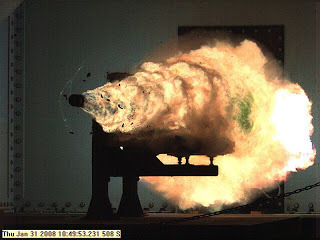
RAILGUNS "The Series"
As I often plan to do with the this blog, I want to look at the more science related issues in science-fiction writing. Why rail guns? Well, the Epherium Chronicles is set in the mid 22nd century and the primary Earth space based weapons are rail guns. My goal with series of posts is not only to educate other about rail guns (their origin and function), but to compare them to other weapons and explain some of the advances made to them for my sci-fi book series. It's the whole world building thing.
Plus, the picture of the rail gun fired from a naval test platform is really cool and I had to share.
First of all, what is a rail gun. Here is wikipedia's quick explanation:
A railgun is an electrically powered electromagnetic projectile launcher based on similar principles to the homopolar motor. A railgun comprises a pair of parallel conducting rails, along which a sliding armature is accelerated by the electromagnetic effects of a current that flows down one rail, into the armature and then back along the other rail.
Straightforward isn't it. Well, a railgun originally was a very simple design based on the theory of the traditional electric motor. You see for most of us engineering types, once the blood gets in the water on a new and cool topic, we are on it like sharks. It wasn't different for the concept of electric motors. Once the first few motor designs were developed a whole new engineering craze on the subject began.
Anyway, now for the motors.
You see, the traditional electric motors look something like this (for purposes of brevity, I using one example of a DC motor and not an AC one or the multitude of variations...its my blog and I show the examples).
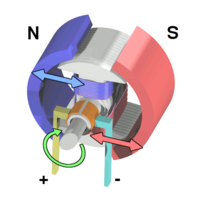
Since there are so many types, I don't want to bog you down with the details, but what I want to show is this. When you apply electric current to the motor, the magnetic field generated create an electromotive force. In the case of a standard motor the force causes the armature in the center to spin. The higher the current, the faster it moves.
So if this a motor, what does a railgun have to do with it? Well, a railgun is essential a linear motor, where the force generated moves in a straight line. This next diagram depicts a simple concept of a railgun.
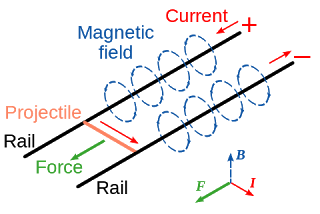
The railgun rails are parallel rails that electric current travels. When current flows through a conductor like the rails, it generates a magnetic field. In this case, the projectile is the armature and becomes a circuit bridge, thus allowing the electric current to run across from one of the rails to the other. As the current travels, the magnetic fields create a linear electromotive force that pushes the project down the rails. The higher the current, the create the acceleration.
In the next part of the series, we will talk history of the railgun, look at different approach to a linear motor weapon, and compare them to traditional types of weapons used today. Nothing like examples to let your mind relate to scientific jargon.
Please feel free to comment and share you thoughts. This is fun stuff and I love to talk about. Later on in this series we will look at how these weapons have been used in Sci-fi books, movies, or TV. Are there depictions accurate or too far fetched?
Published on September 10, 2013 20:23
September 9, 2013
Every year I have a list of TV series that I really want ...
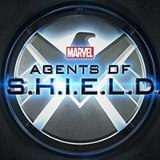
Every year I have a list of TV series that I really want to take time to watch; even if I have to DVR them for a month to find a slot. Agents of S.H.I.E.L.D has a lot of promise. I loved Agent Colson's character and hopefully, we might see guest appearances of the other Avengers (Black Widow and Hawkeye being the easiest). I also think it would be a good way to integrate Quicksilver and the Scarlet Witch into story line before the second Avenger's movie. Another good slant would be to introduce Sharon Carter, Agent Peggy Carter's niece. There is so much source material to use and I think Marvel has really excelled in putting the characters we love in a developed story line we can enjoy.
There are several Marvel movies coming, but this series can be a foundation for many of them and it can teach us more about S.H.I.E.L.D. After a great summer of action, sci-fi, and superhero movies, this fall looks really bright.
Published on September 09, 2013 20:13
August 30, 2013
Embrace update time. I have spoken with my edi...
Embrace update time. I have spoken with my editor and I should have my first round of edits late next week. Cover work has begun as well. I am really excited to see what they design for it. Based on the latest information I have received, the pub date for Embrace will be March 4, 2014. I don't have any info on Crucible.
Now, I am steadily working on Echoes. Even my best attempt at a descriptive outline hasn't survived this one. I continue to go back to Stephen King's lessons in his book, On Writing. I just put a group of characters into a situation and write what happens around them as you start the clock and time moves forward. Its really fun to watch how fluid interactions with other characters can get, and how awkward.
Now, I am steadily working on Echoes. Even my best attempt at a descriptive outline hasn't survived this one. I continue to go back to Stephen King's lessons in his book, On Writing. I just put a group of characters into a situation and write what happens around them as you start the clock and time moves forward. Its really fun to watch how fluid interactions with other characters can get, and how awkward.
Published on August 30, 2013 20:26
Wanted to post this in thanks to Parajukee and Alison Can...

Wanted to post this in thanks to Parajukee and Alison Can Read for the Feature Follow Blog Hop. Thanks for organizing this.
This week's question for this blog hop:
If you could only have ONE - one book - for the rest of your life. Don't cheat...What would it be?
Answer:
Truly a tough one for me. The Bible would be my first choice. That's just me. But if I had a fictional book to take as a second, I would have to pick Mary Shelly's Frankenstein. I have some really favorite authors I love to read. Margaret Weis, Tracy Hickman, Jim Butcher, R.A. Salvatore, Kevin J. Anderson, Robert Jordan, and the list goes on, but in college we took time to not only read, but study Mary Shelly's work. The whole plot concept and interweaving of tragedy from both the doctor and the monster was terrific.
Published on August 30, 2013 12:19
August 24, 2013
I know I haven't posted much lately about my book series,...
I know I haven't posted much lately about my book series, The Epherium Chronicles. Well, there was a reason. I recently pulled down my self-published novels from all the distributors and I have signed a three book deal for the series with Carina Press. I am excited about this opportunity and I am sure many of you are excited to see this series really take off. The plan is to have the sci-fi space opera released in early 2014. I don't have an official pub date, but I believe it will be late January or early February.
I still plan to do at least five for this series and book three is in the works. I wanted to start this novel, Echoes, off with a bang and, if the first chapter is any indication, I think I've done exactly that.
Anyway, here is the post on Publisher's Marketplace for the deal.
August 22, 2013[image error][image error] Digital: Fiction: Sci-Fi/Fantasy T.D. Wilson's space opera trilogy THE EPHERIUM CHRONICLES, in which the Earth Defence Force must defeat alien menaces and dark agendas in order to protect legions of human colonists in faraway solar systems, to Angela James at Carina Press, for publication beginning in 2014, by Laura Wood atFinePrint Literary Management (World).[image error]
I will continue to update you all on the progress of things, including releases of new cover art. I can't use the old covers, but I'm sure these new ones will really catch your eye.
I still plan to do at least five for this series and book three is in the works. I wanted to start this novel, Echoes, off with a bang and, if the first chapter is any indication, I think I've done exactly that.
Anyway, here is the post on Publisher's Marketplace for the deal.
August 22, 2013[image error][image error] Digital: Fiction: Sci-Fi/Fantasy T.D. Wilson's space opera trilogy THE EPHERIUM CHRONICLES, in which the Earth Defence Force must defeat alien menaces and dark agendas in order to protect legions of human colonists in faraway solar systems, to Angela James at Carina Press, for publication beginning in 2014, by Laura Wood atFinePrint Literary Management (World).[image error]
I will continue to update you all on the progress of things, including releases of new cover art. I can't use the old covers, but I'm sure these new ones will really catch your eye.
Published on August 24, 2013 20:23



